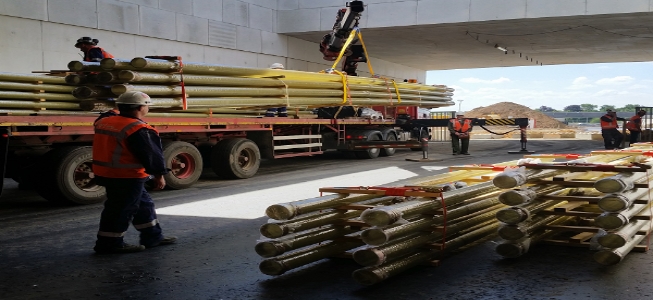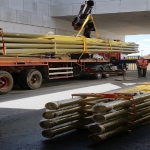Versteden has completed the installation of a 4.2 km firewater system for the new A2 motorway multi-level road tunnel in Maastricht. This means a reliable availability of water for potential fire situations inside the tunnel. Aliancys and Euroresins supported Versteden in this development with Atlac resin systems. The A2 motorway is the most important North-South road connection in the Netherlands, carrying a very heavy traffic load. In Maastricht the A2 motorway originally passed the town above ground, cutting the city in half. Because of the limited space available and the need to have local traffic cross the motorway, speed limits were only 50 km per hour causing major traffic delays in rush hours. Consequently, noise and exhaust gases were of great annoyance to the residents living nearby, and were having a negative effect on the environment. In 2008 the Dutch government decided to construct a new tunnel (King Willem-Alexander tunnel) at the location of the existing motorway. This is the first two-layer tunnel in the Netherlands, with the top level designated for local traffic, and the lower level used for transit traffic. On top of the tunnel a new green corridor will be created, improving quality of living for local residents in Maastricht. The new 2.3 km tunnel will safely process a large amount of traffic at both levels, and consequently reduce the impact of the traffic on the environment. The tunnel was commissioned by the Dutch National Body of Roads and Waterways (Rijkswaterstaat) and constructed by Ballast Nedam and Strukton. The tunnel construction was completed in 2015, and it has been open to traffic since December 2016. A reliable firewater system had to be installed as safety precaution in the event of a tunnel fire or a major traffic incident. Tunnel fire regulations require the firewater system to be operational at all times. It was clear from the beginning of project engineering that conventional steel pipes would not be acceptable, because of the risk of corrosion inside the pipes and as a result potential output limitations. For that reason the firewater system was originally envisioned to be constructed in stainless steel. However, after project kick-off it was found that total system cost was going to be unacceptably high, there was a high risk of corrosion pitting of the welds, and there were major issues with steel pipe raw material availability potentially delaying the entire project. Versteden came up with an integrated solution for this challenge. “We could provide system design, manufacturing and installation all in one hand, with easy and direct communication between the parties,” reports Peter Bogers, Managing Director of Versteden. “Besides being able to deliver fast and at competitive price, we helped to keep the overall project timeline on track. For project owner Rijkswaterstaat this was obviously a major benefit.” The heart of the new firewater system is formed by a 125 mm diameter composite pipe network (ISO 14692 standard), installed inside the tunnel emergency tubes (located in between the main traffic tubes). In total, Versteden supplied 4.2 km of piping. The resin system used in this project is a novel Atlac resin supplied by Aliancys through its distributor Euroresins. “Aliancys and Euroresins have helped us to fine-tune resin formulation and provide support in promoting our GRE piping systems,” says Peter Bogers. “With the support of both companies we can much better promote the benefits of composites solutions, and convince key stakeholders about the attractive economics and long term reliability of firewater systems in these materials.”













